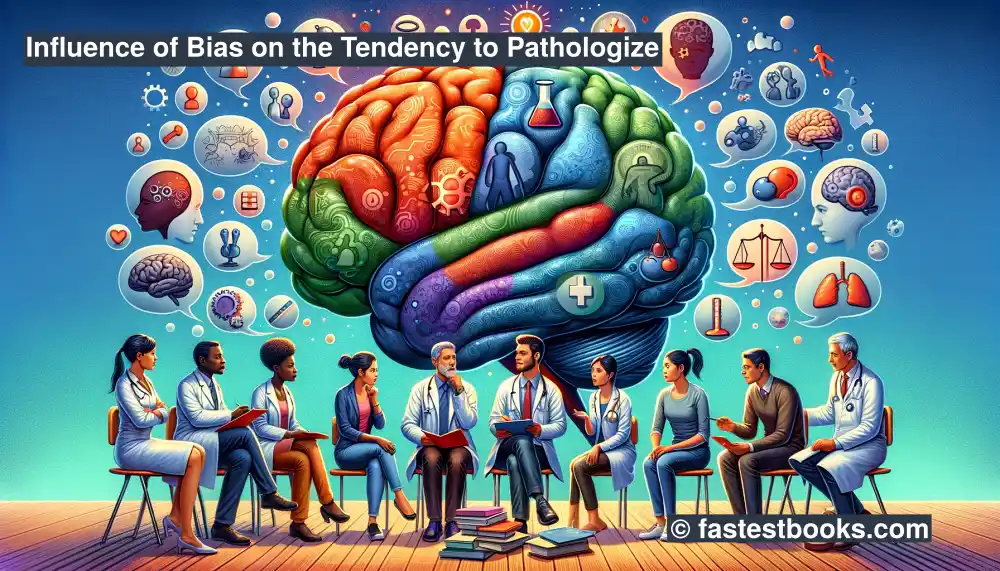
Bias – influence on the tendency to pathologize
How Does Bias Influence the Tendency to Pathologize?
Pathologization, the process of viewing or treating behaviors or conditions as abnormal or diseased, is influenced by a complex interplay of biases. This comprehensive exploration delves into various aspects of bias in the medical field, particularly focusing on psychology and psychiatry, and their impact on mental health and mental illness.
What Does Pathologizing Mean?
Pathologizing is the act of treating normal behaviors or conditions as pathological or abnormal, often influenced by biases. It’s a critical issue in healthcare, leading to misdiagnoses and inappropriate treatments, particularly in mental health disorders.
Disruptive Behavior Disorders and ADHD: Prevalence, Disparities, and Risk Factors
Disruptive behavior disorders and ADHD are commonly diagnosed in children and adolescents, with significant racial and ethnic disparities in diagnosis. These disparities highlight the role of implicit bias and socio-economic status in pathologizing behaviors that may not align with a correct diagnosis of a psychiatric disorder.
Misrepresenting Race — The Role of Medical Schools in Propagating Physician Bias
Medical schools play a crucial role in shaping physician biases, particularly regarding race. The lack of comprehensive medical knowledge and perspective taking in academic medicine often leads to racial bias and health disparities, particularly in the diagnosis of mental health conditions like major depressive disorder and generalized anxiety disorder.
Disruptive Behavior Disorders and ADHD: Challenges in Assessment
Assessing these disorders poses challenges due to biases in clinical judgment and decision-making. This is compounded by a lack of understanding in the Diagnostic and Statistical Manual of Mental Disorders used by mental health professionals, leading to overdiagnosis of conditions like attention deficit hyperactivity disorder (ADHD) and misdiagnoses of mood disorders.
Prevalence without Context
Often, the prevalence of certain disorders is reported without adequate context, ignoring environmental factors and the socio-economic and cultural factors that contribute to these statistics, thus contributing to health inequities.
But why does this happen?
This bias often stems from cognitive biases and systemic issues within healthcare education and practice, including implicit racial bias and the tendency to pathologize certain racial groups more than others.
Race-Based Diagnostic Bias
Racial disparities in mental health diagnosis, such as overdiagnosis of schizophrenia in black patients and underdiagnosis of affective disorders in white patients, demonstrate the impact of racial bias in clinical decision-making.
Systemic Biases and Structural Racism
The healthcare system itself is imbued with systemic biases and structural racism, influencing everything from diagnosis to treatment plans, resulting in significant health care disparities.
Clinician Biases
Clinicians’ personal biases, often subconscious, significantly impact their diagnostic decisions and treatment recommendations, particularly in mental healthcare. This includes biases in diagnosing substance use disorders and personality disorders.
Pathologizing Race
Interpreting racial characteristics as pathological, a practice known as pathologizing race, is a deeply flawed and harmful practice. This can lead to misrepresentation of racial differences in various mental illnesses, contributing to public health challenges.
Addressing Unconscious Bias in Psychiatry Training
To combat these biases, there is a growing emphasis on addressing unconscious biases in psychiatry and psychology training programs, focusing on reducing bias in clinical judgments and improving diagnostic accuracy.
Race-Based Clinical Guidelines
Some clinical guidelines are influenced by race-based assumptions, which can lead to biased healthcare delivery and diagnostic decision-making, especially in conditions like bipolar disorder and psychotic disorders.
Systemic Factors
Various systemic factors, including healthcare policies and institutional practices, contribute to the pathologization of certain groups, leading to mental health services disparities.
4 Examples of Pathologizing
- Overreliance on medications in treating mental disorders, as noted by mental health professionals, can reflect a trend in pathologizing rather than addressing underlying issues.
- Clinical judgment in nursing often reflects personal biases, impacting patient outcomes in the treatment of mental illnesses.
- Strategies to overcome bias in mental health include systematic reviews and meta-analyses to inform clinical practice and reduce health disparities.
- Increasing diagnosis of mental health disorders like mood disorders and anxiety disorders can sometimes reflect pathologizing normal behavior.
Why is this a problem in psychology?
In psychology, pathologizing normal behavior can lead to unnecessary treatment and stigmatization of individuals, particularly in areas of abnormal psychology and mental health diagnosis.
Structural Competency
Understanding and addressing the structural factors contributing to biases in healthcare is crucial for effective and equitable healthcare delivery, especially in professional psychology.
Do We Pathologize ‘Normal’ Behavior?
There is a growing concern that what is considered ‘normal’ behavior is increasingly being pathologized due to various biases, leading to an increase in mental health disorders diagnoses.
PositivePsychology.com’s Relevant Resources
Resources from PositivePsychology.com highlight the importance of understanding and addressing biases in clinical practice, especially in the context of mental health and psychiatric disorders.
Medicalizing mental health
The trend of medicalizing normal aspects of mental health, such as everyday stress and mood fluctuations, raises concerns about overdiagnosis and overmedication in mental healthcare.
Increasing mental health disorders
The apparent increase in mental health disorders might reflect a societal trend towards pathologizing rather than a genuine increase in incidence, influenced by cultural and racial disparities in mental health services.
1. Types of biases
Understanding the different types of biases, including cognitive, cultural, and confirmation biases, is crucial in tackling pathologization in mental health and healthcare professions.
2. Nurses’ clinical judgment and patient outcomes
Nurses’ clinical judgments, influenced by their biases, significantly impact patient outcomes, especially in diagnosing and treating mental health conditions.
3. Review and extraction
A critical review and extraction of biased practices in healthcare can help identify areas for improvement, especially in the context of psychiatric and psychological assessments.
Conclusion
Understanding and addressing the various biases that lead to pathologization is essential for providing equitable and accurate healthcare. Awareness, education, and systemic changes are key to combating this pervasive issue in mental health and general healthcare.



